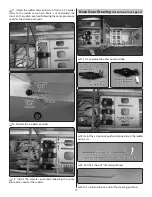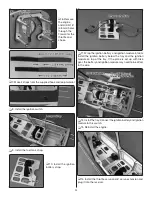
33
C.G. locations so you will be able to feel them when lifting the
model with your fi ngers to check the C.G. location.
Do not
at any time balance the model outside this C.G. range.
❏
3. Use Great Planes “stick on” weight (GPMQ4485) to
balance the plane. Place incrementally increasing amounts
of weight on the bottom of the fuselage over the location
where it would be mounted inside until the model balances. A
good place to add stick-on nose weight is to the fi rewall. Do
not attach weight to the cowl—this will cause stress on the
cowl and could cause the cowl to crack at the screw holes.
Once you have determined if additional weight needs to be
installed, permanently attach the weight with glue or screws.
If tail weight is needed, remove the covering from over the
weight hatch, install the weight and install the hatch cover.
❏
4.
IMPORTANT:
If you found it necessary to add any
weight, recheck the C.G. after the weight has been installed.
PREFLIGHT
Identify Your Model
You should always have your name, address, telephone
number and AMA number on or inside your model. It is
required
at all AMA R/C club fl ying sites and AMA sanctioned
fl ying events. Fill out the identifi cation tag on the decal sheet
and place it on or inside your model.
Charge the Batteries
Always charge your transmitter and receiver batteries the night
before you go fl ying, and at other times as recommended
by the radio manufacturer.
CAUTION:
Unless the instructions that came with your
radio system state differently, the
initial
charge on
new
transmitter and NiMH receiver batteries should be done
for 15 hours
using the slow-charger that came with the
radio system
. This will “condition” the batteries so that the
next charge may be done using the fast-charger of your
choice. If the initial charge is done with a fast-charger the
batteries may not reach their full capacity and you may be
fl ying with batteries that are only partially charged.
Ground Check and Range Check
Make sure the engine idles reliably, transitions smoothly
and maintains full power indefi nitely. Shut the engine off
and inspect the model closely, making sure all fasteners,
pushrods and connections have remained tight and the hinges
are secure. Follow the radio manufacturer's instructions to
ground check the operational range of your radio before
the fi rst fl ight of the day. This should be done once with
the engine off and once with the engine running at various
speeds. If the control surfaces do not respond correctly,
do
not fl y!
Find and correct the problem fi rst. Look for loose
servo connections or broken wires, corroded wires on old
servo connectors, poor solder joints in your battery pack or
a defective battery cell.
ENGINE SAFETY PRECAUTIONS
Failure to follow these safety precautions may result
in severe injury to yourself and others.
●
Keep all engine fuel in a safe place, away from high heat,
sparks or fl ames, as fuel is very fl ammable. Do not smoke
near the engine or fuel; and remember that engine exhaust
gives off a great deal of deadly carbon monoxide. Therefore
do not run the engine in a closed room or garage.
●
Get help from an experienced pilot when learning to
operate engines.
●
Use safety glasses when starting or running engines.
●
Use a “chicken stick” or electric starter to start the engine.
If you do flip the propeller with your fingers, wear a heavy
leather glove, such as a welder’s glove. When hand starting
gas engines, if the engine should backfire, the large prop
can cause severe injury to your hand and fingers.
●
Do not run the engine in an area of loose gravel or sand;
the propeller may throw such material in your face or eyes.
●
Keep your face and body as well as all spectators away
from the plane of rotation of the propeller as you start and
run the engine.




































